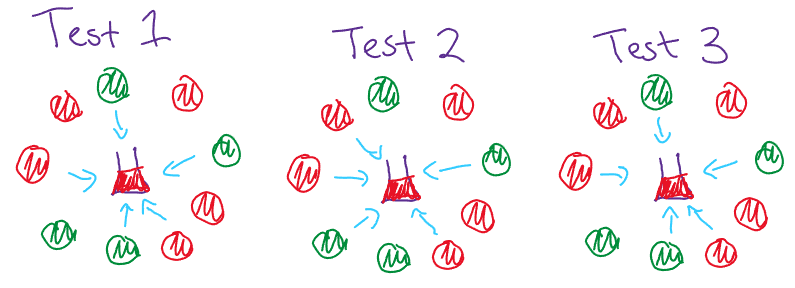A post by Rahil Morjaria, PhD student on the Compass programme.
What is Group Testing?
Group Testing was first introduced in the 1940s as a way to test military recruits for syphilis during World War II. By combining blood samples, they hoped to reduce the total number of tests needed to detect the diseased individuals (compared to testing each recruit individually).

Example of pooling blood samples, where red and green depicts diseased and not diseased respectively.
Since then, there have been many advances in Group Testing with applications not just in detecting diseased individuals but also in communications, cybersecurity and data storage. In essence, whenever we have a situation where we need to detect a proportionally rare occurrence, Group Testing is probably applicable.
More formally, if we have some diseased set of individuals of size $k$ of a total population $n$, it might be considered (instead of testing each individual separately) to pool people together into groups (with replacement) and test these groups.

Matrix Form of Group Testing (each row depicting a test and each column depicting a member of the population) [1].
We often write our test design in matrix form where each row is a group/test and each column indicates a member of the population, where a $1$ indicates a individuals inclusion in a test.
The relationship between $k$ and $n$ is quite important, our focus is on the sparse case in which $k = O(n^\alpha)$ where $\alpha \in (0,1)$.
Often we assume our test apparatus is sensitive enough where a single diseased individual in the test will give us a positive result (as shown in the image above) this is known as the noiseless case (there is vast amounts of work done for different types of noise, for more information check out [1]).
Adaptive vs Non-Adaptive Group Testing
Adaptive Group Testing (as the name suggests) allows us to adapt our subsequent tests by the results of the previous. If we compare this to Non-Adaptive Group Testing, in which we have to define our tests (and thus our groups) before we obtain any results, we can expect stronger results.
As our tests have binary outputs, we can obtain at most $1$ bit of information per test. As there are $\binom{n}{k}$ possible defective sets, we would need $\log_2\binom{n}{k}$ bits to uniquely represent each possible set. This gives us the limit of $\log_2\binom{n}{k}$ tests needed, this is known as a converse result, a fundamental limit which we are unable to overcome.
In the noiseless case, Adaptive Group Testing is able to achieve this fundamental limit. First we split our total items $n$ into $k$ (the number of defective items) subsets of length $n/k$ without replacement, and then perform Binary Splitting.

Binary Splitting Adaptive Algorithm.
While Adaptive Group Testing is able to reach fundamental limits, our main focus is on Non-Adaptive Group Testing. Non-Adaptive Group Testing has many applications due to it’s ability to be ran in parallel (and other ease of use situations).
Non-Adaptive Group Testing procedures are often designed randomly (in which each items inclusion in a test is $Bern(v)$ for some $v$) or with near constant column weight (each item is in ‘nearly’ the same amount of tests). Out of these 2 designs near constant column weight gives stronger results.
 A graph comparing different group testing designs, where the $\text{Rate} = \log_2\binom{n}{k}/T$ where $T$ is the number of tests needed to recover all the defective items (with high probability for the red lines and with certainty for the purple line). [1]
A graph comparing different group testing designs, where the $\text{Rate} = \log_2\binom{n}{k}/T$ where $T$ is the number of tests needed to recover all the defective items (with high probability for the red lines and with certainty for the purple line). [1]
Goals
While there are many strong results in Group Testing, there is still much to explore. From looking at List Decoding (in which we allow a list of possible defective sets to be outputted), other forms of noise and our efficient algorithms still not being able to match up to our theoretical achievable methods, there is work to be done in all aspects. With improvements in technology, combined with the myriad of applications, the future of Group Testing definitely looks bright!
References:
[1] M. Aldridge, O. Johnson, and J. Scarlett. Group testing: an information theory perspective. CoRR, abs/1902.06002, 2019. URL http://arxiv.org/abs/1902.06002.

